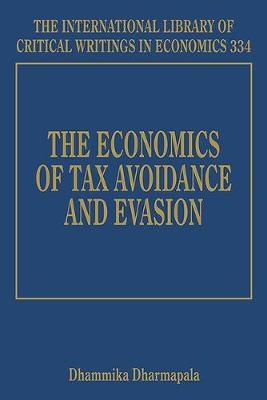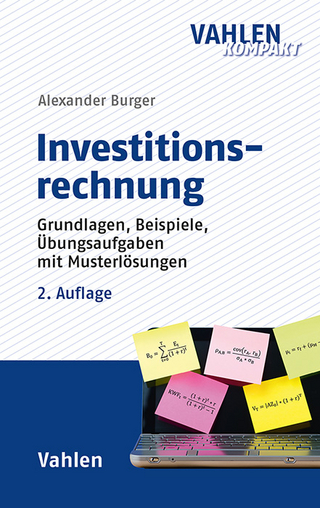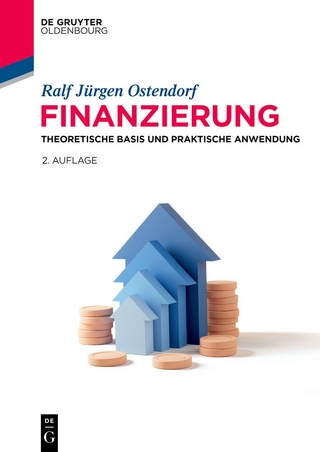
The Economics of Tax Avoidance and Evasion
Edward Elgar Publishing Ltd (Verlag)
978-1-78536-744-1 (ISBN)
Tax compliance issues enjoy an unprecedented degree of public attention today and are of great importance to governments and policymaking. This research review provides an overview of some of the most significant contributions to the economic analysis of tax avoidance and evasion and also sheds light on broader questions of social organization, behaviour, and compliance with the law. This research review provides researchers and students with a guide to the fundamental intellectual developments that have shaped the economic understanding of tax avoidance and evasion, along with a framework for placing these contributions in their intellectual context.
Edited by Dhammika Dharmapala, Julius Kreeger Professor of Law, University of Chicago Law School, US
Contents:
Introduction Dhammika Dharmapala
PART I PIONEERING CONTRIBUTIONS TO THE THEORY OF TAX EVASION
1. Michael G. Allingham and Agnar Sandmo (1972), ‘Income Tax Evasion: A Theoretical Analysis’, Journal of Public Economics, 1 (3-4), 323–38
2. T.N. Srinivasan (1973), ‘Tax Evasion: A Model’, Journal of Public Economics, 2 (4), 339–46
3. Shlomo Yitzhaki (1974), ‘A Note on Income Tax Evasion: A Theoretical Analysis’, Journal of Public Economics, 3 (2), 201–2
PART II PIONEERING EMPIRICAL STUDIES OF TAX EVASION
4. Charles T. Clotfelter (1983), ‘Tax Evasion and Tax Rates: An Analysis of Individual Returns’, Review of Economics and Statistics, LXV (3), August, 363–73
5. Jonathan S. Feinstein (1991), ‘An Econometric Analysis of Income Tax Evasion and its Detection’, RAND Journal of Economics, 22 (1), Spring, 14–35
6. James Alm, Gary H. McClelland and William D. Schulze (1992), ‘Why do People Pay Taxes?’, Journal of Public Economics, 48 (1), June, 21–38
7. Joel Slemrod, Marsha Blumenthal and Charles Christian (2001), ‘Taxpayer Response to an Increased Probability of Audit: Evidence from a Controlled Experiment in Minnesota’, Journal of Public Economics, 79 (3), March, 455–83
8. Marsha Blumenthal, Charles Christian, Joel Slemrod and Matthew G. Smith (2001), ‘Do Normative Appeals Affect Tax Compliance? Evidence from a Controlled Experiment in Minnesota’, National Tax Journal, 54 (1), March, 125–38
PART IIITHEORIES OF TAX AUDITING: PRINCIPAL-AGENT AND GAME-THEORETIC PERSPECTIVES
9. Jennifer F. Reinganum and Louis L. Wilde (1985), ‘Income Tax Compliance in a Principal-Agent Framework’, Journal of Public Economics, 26 (1), February, 1–18
10. Michael J. Graetz, Jennifer F. Reinganum and Louis L. Wilde (1986), ‘The Tax Compliance Game: Toward an Interactive Theory of Law Enforcement, Journal of Law, Economics and Organization, 2 (1), Spring, 1–32
11. Parkash Chander and Louis L. Wilde (1998), ‘A General Characterization of Optimal Income Tax Enforcement’, Review of Economic Studies, 65 (1), January, 165–83
PART IV TOPICS IN TAX ADMINISTRATION
12. Joel Slemrod and Shlomo Yitzhaki (1987), ‘The Optimal Size of a Tax Collection Agency’, Scandinavian Journal of Economics, 89 (2), June, 183–92
13. Parkash Chander and Louis Wilde (1992), ‘Corruption in Tax Administration’, Journal of Public Economics, 49 (3), December, 333–49
14. Dhammika Dharmapala, Joel Slemrod and John Douglas Wilson (2011), ‘Tax Policy and the Missing Middle: Optimal Tax Remittance with Firm-Level Administrative Costs’, Journal of Public Economics, 95 (9-10), October, 1036–47
15. Adnan Q. Khan, Asim I. Khwaja and Benjamin A. Olken (2016), ‘Tax Farming Redux: Experimental Evidence on Performance Pay for Tax Collectors’, Quarterly Journal of Economics, 131 (1), February, 219–71
PART IV THE IMPLICATIONS OF TAX EVASION FOR THE THEORY OF OPTIMAL TAXATION
16. Louis Kaplow (1990), ‘Optimal Taxation with Costly Enforcement and Evasion’, Journal of Public Economics, 43 (2), November, 221–36
17. Helmuth Cremer and Firouz Gahvari (1995), ‘Tax Evasion and the Optimum General Income Tax’, Journal of Public Economics, 60 (2), May, 235–49
PART VI CORPORATE TAX EVASION: THEORETICAL PERSPECTIVES
18. Kong-Pin Chen and C.Y. Cyrus Chu (2005), ‘Internal Control versus External Manipulation: A Model of Corporate Income Tax Evasion’, RAND Journal of Economics, 36 (1), Spring, 151–64
19. Keith J. Crocker and Joel Slemrod (2005), ‘Corporate Tax Evasion with Agency Costs’, Journal of Public Economics, 89 (9 -10), September, 1593–610
PART VII INFORMATION REPORTING AND THE ROLE OF INTERMEDIARIES IN TAX COMPLIANCE
20. Henrik Jacobsen Kleven, Martin B. Knudsen, Claus Thustrup Kreiner, Søren Pedersen and Emmanuel Saez (2011), ‘Unwilling or Unable to Cheat? Evidence from a Tax Audit Experiment in Denmark’, Econometrica, 79 (3), May, 651–92
21. Dina Pomeranz (2015), ‘No Taxation without Information: Deterrence and Self-Enforcement in the Value Added Tax’, American Economic Review, 105 (8), August, 2539–69
22. Henrik Jacobsen Kleven, Claus Thustrup Kreiner and Emmanuel Saez (2016), ‘Why Can Modern Governments Tax So Much? An Agency Model of Firms as Fiscal Intermediaries’, Economica, 83 (330), April, 219–46
PART VIII CROSS-BORDER TAX EVASION
23. Philippe Bacchetta and Maria Paz Espinosa (1995), ‘Information Sharing and Tax Competition among Governments’, Journal of International Economics, 39 (1-2), August, 103–21
24. Gabriel Zucman (2013), ‘The Missing Wealth of Nations: Are Europe and the U.S. Net Debtors or Net Creditors?’, Quarterly Journal of Economics, 128 (3), 1321–64
PART IX GENERAL PERSPECTIVES ON TAX AVOIDANCE
25. Joseph E. Stiglitz (1985), ‘The General Theory of Tax Avoidance’, National Tax Journal, 38 (3), September, 325–37
26. Alan J. Auerbach (1991), ‘Retrospective Capital Gains Taxation’, American Economic Review, 81 (1), March, 167–78
27. David A Weisbach (2002), ‘An Economic Analysis of Anti‐Tax‐Avoidance Doctrines’, American Law and Economics Review, 4 (1), Spring, 88–115
PART X CORPORATE TAX AVOIDANCE
28. Mihir A. Desai and Dhammika Dharmapala (2006), ‘Corporate Tax Avoidance and High-powered Incentives’, Journal of Financial Economics, 79 (1), January, 145–79
29. Mihir A. Desai and Dhammika Dharmapala (2009), ‘Corporate Tax Avoidance and Firm Value’, Review of Economics and Statistics, 91 (3), August, 537–46
30. Michelle Hanlon and Joel Slemrod (2009), ‘What does Tax Aggressiveness Signal? Evidence from Stock Price Reactions to News about Tax Shelter Involvement’, Journal of Public Economics, 93 (1-2), February, 126–41
PART XI BASE EROSION AND PROFIT SHIFTING BY MULTINATIONAL FIRMS
31. James R. Hines, Jr. and Eric M. Rice (1994), ‘Fiscal Paradise: Foreign Tax Havens and American Business’, Quarterly Journal of Economics, 109 (1), February, 149–82
32. Harry Huizinga and Luc Laeven (2008), ‘International Profit Shifting within Multinationals: A Multi-country Perspective’, Journal of Public Economics, 92 (5-6), June, 1164–82
33. Dhammika Dharmapala and Nadine Riedel (2013), ‘Earnings Shocks and Tax-motivated Income-shifting: Evidence from European Multinationals’, Journal of Public Economics, 97, January, 95–107
PART XII TAX AVOIDANCE AND THE DEADWEIGHT LOSS OF TAXATION
34. Martin Feldstein (1999), ‘Tax Avoidance and the Deadweight Loss of the Income Tax’, Review of Economics and Statistics, 81 (4), November, 674–80
35. Joel Slemrod (2001), ‘A General Model of the Behavioral Response to Taxation’, International Tax and Public Finance, 8 (2), March, 119–28
36. Raj Chetty (2009), ‘Is the Taxable Income Elasticity Sufficient to Calculate Deadweight Loss? The Implications of Evasion and Avoidance’, American Economic Journal: Economic Policy, 1 (2), August, 31–52
PART XIII BUNCHING ANALYSIS OF TAX EVASION AND AVOIDANCE: EVIDENCE FROM NOTCHES AND KINKS
37. Joel Slemrod (1985), ‘An Empirical Test for Tax Evasion’, Review of Economics and Statistics, 67 (2), May, 232–38
38. Emmanuel Saez (2010), ‘Do Taxpayers Bunch at Kink Points?’, American Economic Journal: Economic Policy, 2 (3), August, 180–212
39. Michael Carlos Best, Anne Brockmeyer, Henrik Jacobsen Kleven, Johannes Spinnewijn and Mazhar Waseem (2015), ‘Production versus Revenue Efficiency with Limited Tax Capacity: Theory and Evidence from Pakistan’, Journal of Political Economy, 123 (6), October, 1311–55
PART XIV THE CONSEQUENCES OF TAX AMNESTIES AND OF TAX HOLIDAYS FOR MULTINATIONAL FIRMS
40. James Andreoni (1991), ‘The Desirability of a Permanent Tax Amnesty’, Journal of Public Economics, 45 (2), 143–59
41. Dhammika Dharmapala, C. Fritz Foley and Kristin J. Forbes (2011), ‘Watch What I do, Not What I Say: The Unintended Consequences of the Homeland Investment Act’, Journal of Finance, 66 (3), June, 753–87
PART XV THE CHARACTERISTICS OF TAX HAVENS, AND THEIR ROLE IN TAX AVOIDANCE AND EVASION
42. Mihir A. Desai, C. Fritz Foley and James R. Hines, Jr. (2006), ‘The Demand for Tax Haven Operations’, Journal of Public Economics, 90 (3), March, 513–31
43. Dhammika Dharmapala and James R. Hines, Jr. (2009), ‘Which Countries become Tax Havens?’, Journal of Public Economics, 93 (9-10), October, 1058–68
44. Niels Johannesen and Gabriel Zucman (2014), ‘The End of Bank Secrecy? An Evaluation of the G20 Tax Haven Crackdown’, American Economic Journal: Economic Policy, 6 (1), 65–91
Index
| Erscheinungsdatum | 01.02.2018 |
|---|---|
| Reihe/Serie | The International Library of Critical Writings in Economics series |
| Verlagsort | Cheltenham |
| Sprache | englisch |
| Maße | 169 x 244 mm |
| Themenwelt | Recht / Steuern ► Steuern / Steuerrecht |
| Wirtschaft ► Betriebswirtschaft / Management ► Finanzierung | |
| Wirtschaft ► Volkswirtschaftslehre ► Wirtschaftspolitik | |
| ISBN-10 | 1-78536-744-7 / 1785367447 |
| ISBN-13 | 978-1-78536-744-1 / 9781785367441 |
| Zustand | Neuware |
| Haben Sie eine Frage zum Produkt? |
aus dem Bereich


